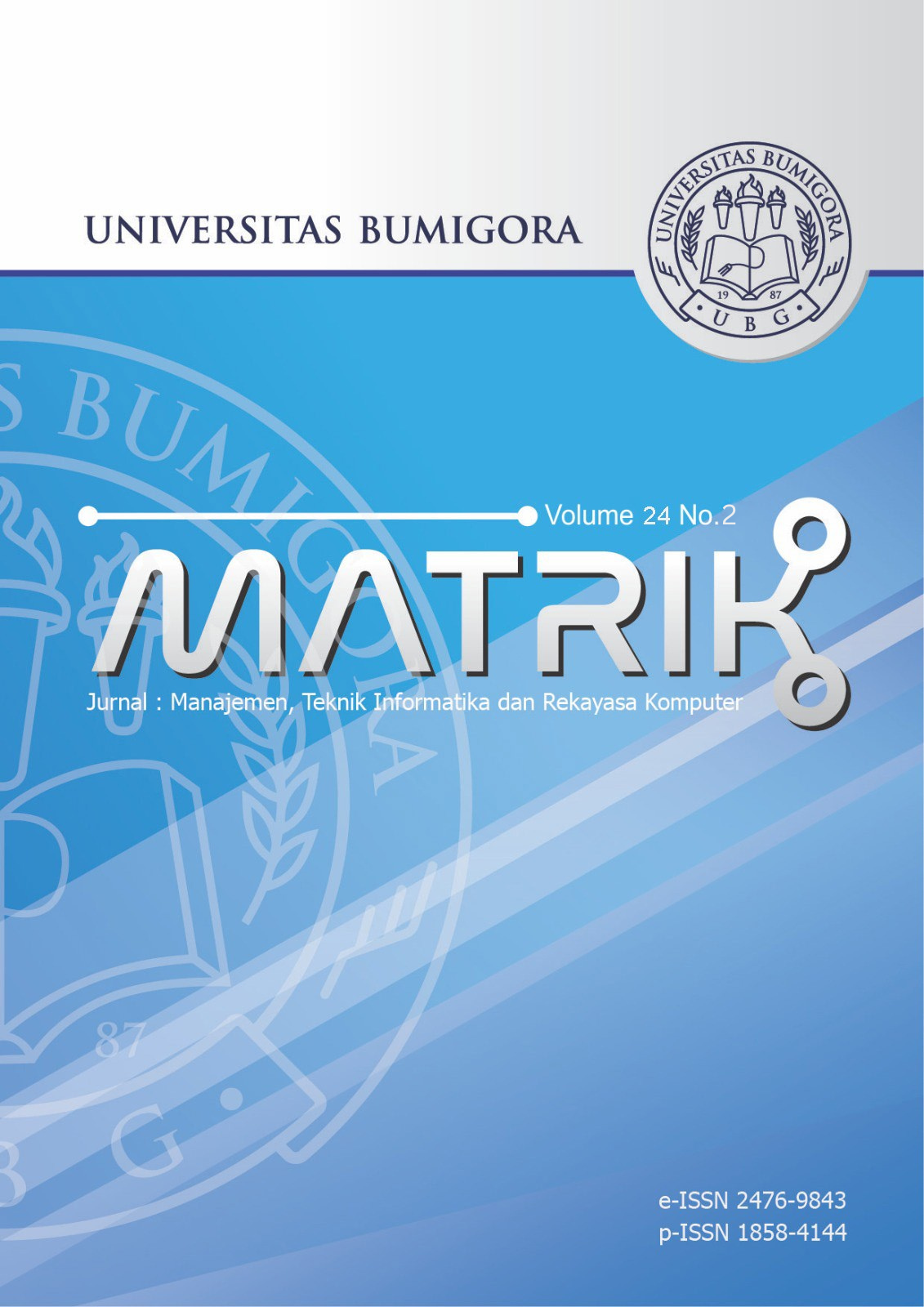Predicting Gen Z’s Sentiments on Gorontalo’s CulturalWisdom UsingSentiment Analysis Models
DOI:
https://doi.org/10.30812/matrik.v24i2.4591Keywords:
Dikili, Generation Z, Local Culture Gorontalo, Meeraji, Naive Bayes, Sentiment AnalysisAbstract
In the digital era, Generation Z faces both opportunities and challenges in understanding and preserving local cultural wisdom. It is essential to ensure that cultural values go beyond superficial consumption in cyberspace and remain deeply valued as integral aspects of identity and history. As technological advances and globalization continue influencing young people to preserve, local culture presents an increasing challenge. This study aims to determine Generation Z’s perceptions of Gorontalo’s local cultural wisdom, focusing on the Dikili and Meeraji traditions through a sentiment analysis approach. This research method uses the Naive Bayes algorithm to analyze positive, negative, and neutral sentiments derived from text data processed through a structured pre-processing stage. The findings reveal that Generation Z’s perceptions of the Dikili and Meeraji cultures are mostly positive, reflecting a strong appreciation and acceptance of these cultural values. However, the presence of negative sentiment highlights a critical view among some members of Generation Z, who consider certain aspects of these traditions less relevant or controversial in a modern context. In addition, neutral sentiment indicates a segment of young people who may need more exposure or information to form an informed opinion. The study concludes that while Dikili and Meeraji cultures still hold value among Generation Z, a more inclusive and adaptive approach to cultural preservation is needed. The findings offer valuable insights for strategies to preserve and develop local cultural heritage in the digital age.
Downloads
References
Culture: Taking Digital Media Art as an Example,†in Proceedings of the 4th International Conference on Art Studies: Science,
Experience, Education (ICASSEE 2020). Atlantis Press, 2020, pp. 578–582, https://doi.org/10.2991/assehr.k.200907.105.
[2] L. Lazzeretti, “What is the role of culture facing the digital revolution challenge? Some reflections for a research agenda,â€
vol. 30, no. 9, pp. 1617–1637, 2022-09-02, https://doi.org/10.1080/09654313.2020.1836133.
[3] A. Rahmawati, D. M. Astuti, F. H. Harun, and M. K. Rofiq, “Peran Media Sosial dalam Penguatan Moderasi Beragama di
Kalangan Gen-Z,†vol. 3, no. 5, pp. 905–920, 2023-10-02, https://doi.org/10.53625/jabdi.v3i5.6495.
[4] A. D. Murdani and H. Haqqi, “Penguatan Nilai Nasionalisme melalui Kearifan Lokal bagi Gen-Z sebagai Counter Hegemoni
Asing,†vol. 3, no. 4, pp. 236–242, 2023-12-20, https://doi.org/10.31004/jh.v3i4.366.
[5] L. Blandi, M. Sabbatucci, G. Dallagiacoma, F. Alberti, P. Bertuccio, and A. Odone, “Digital Information Approach through
Social Media among Gen Z and Millennials: The Global Scenario during the COVID-19 Pandemic,†vol. 10, no. 11, p. 1822,
2022-10-28, https://doi.org/10.3390/vaccines10111822.
[6] D. Malekpour Koupaei, T. Song, K. S. Cetin, and J. Im, “An assessment of opinions and perceptions of
smart thermostats using aspect-based sentiment analysis of online reviews,†vol. 170, p. 106603, 2020-03, https:
//doi.org/10.1016/j.buildenv.2019.106603.
[7] V. Gooljar, T. Issa, S. Hardin-Ramanan, and B. Abu-Salih, “Sentiment-based predictive models for online purchases in the era
of marketing 5.0: A systematic review,†vol. 11, no. 1, p. 107, 2024-08-05, https://doi.org/10.1186/s40537-024-00947-0.
[8] S. Thomas, Yuliana, and Noviyanti. P, “Study Analisis Metode Analisis Sentimen pada YouTube,†vol. 1, no. 1, pp. 1–7,
2021-03-02, https://doi.org/10.46229/jifotech.v1i1.201.
[9] A. A. Kharlamov and M. Pilgun, “Data Analytics for Predicting Situational Developments in Smart Cities: Assessing User
Perceptions,†vol. 24, no. 15, p. 4810, 2024-01, https://doi.org/10.3390/s24154810.
[10] R. A. Putri, N. A. A. Fitri, and S. Syamsir, “Pengaruh Globalisasi Digital terhadap Budaya di Sumatera Barat,†vol. 3, no. 9,
pp. 32–42, 2024-05-24, https://doi.org/10.6578/triwikrama.v3i9.3308.
[11] Redaksi, “Generasi z: Peran utama dalam era transformasi digital,†2024-04-10, https://langgam.id/
generasi-z-peran-utama-dalam-era-transformasi-digital/.
[12] W. B. Zulfikar, A. R. Atmadja, and S. F. Pratama, “Sentiment Analysis on Social Media Against Public Policy Using
Multinomial Naive Bayes,†vol. 10, no. 1, pp. 25–34, https://doi.org/10.15294/sji.v10i1.39952.
[13] Y. A. Singgalen, “Analisis SentimenWisatawan Melalui Data Ulasan Candi Borobudur di Tripadvisor Menggunakan Algoritma
Na¨ıve Bayes Classifier,†vol. 4, no. 3, 2022-12-26, https://doi.org/10.47065/bits.v4i3.2486.
[14] B. Liu, “Sentiment Analysis: Mining Opinions, Sentiments, and Emotions,†p. 431, 2020-10-15, https://books.google.co.id/
books/about/Sentiment Analysis.html?hl=id&id=PdX7DwAAQBAJ&redir esc=y.
[15] D. R. Daffa, D. Arthuro, J. A. Fernanda, and Muh. BintangWidya Pratama, “Gen-Z: Eksplorasi Identitas Budaya dan Tantangan
Sosial dalam Era Digital,†vol. 2, no. 2, pp. 169–183, 2024-05-08, https://doi.org/10.59581/jipsoshum-widyakarya.v2i2.3112.
[16] C. Ahmed, A. ElKorany, and E. ElSayed, “Prediction of customer’s perception in social networks by integrating sentiment
analysis and machine learning,†vol. 60, no. 3, pp. 829–851, 2023-06-01, https://doi.org/10.1007/s10844-022-00756-y.
[17] J.-Y. Huang, C.-L. Tung, and W.-Z. Lin, “Using Social Network Sentiment Analysis and Genetic Algorithm to
Improve the Stock Prediction Accuracy of the Deep Learning-Based Approach,†vol. 16, no. 1, p. 93, 2023-05-29,
https://doi.org/10.1007/s44196-023-00276-9.
[18] P. Savci and B. Das, “Prediction of the customers’ interests using sentiment analysis in e-commerce data for comparison of
Arabic, English, and Turkish languages,†vol. 35, no. 3, pp. 227–237, 2023-03, https://doi.org/10.1016/j.jksuci.2023.02.017.
[19] R. Singh and R. Singh, “Applications of sentiment analysis and machine learning techniques in disease outbreak prediction –
A review,†vol. 81, pp. 1006–1011, 2023, https://doi.org/10.1016/j.matpr.2021.04.356.
[20] R. L. Mustofa and B. Prasetiyo, “Sentiment analysis using lexicon-based method with naive bayes classifier algorithm on
#newnormal hashtag in twitter,†vol. 1918, no. 4, p. 042155, 2021-06-01, https://doi.org/10.1088/1742-6596/1918/4/042155.
[21] D. A. Kristiyanti, D. A. Putri, E. Indrayuni, A. Nurhadi, and A. H. Umam, “E-Wallet Sentiment Analysis Using Na¨ıve Bayes
and Support Vector Machine Algorithm,†in Journal of Physics: Conference Series, vol. 1641, no. 1. IOP Publishing, 2020, p.
12079, https://doi.org/10.1088/1742-6596/1641/1/012079.
[22] G. Gupta, S. Khan, V. Guleria, A. Almjally, B. I. Alabduallah, T. Siddiqui, B. M. Albahlal, S. A. Alajlan, and M. AL-subaie,
“DDPM: A Dengue Disease Prediction and Diagnosis Model Using Sentiment Analysis and Machine Learning Algorithms,â€
vol. 13, no. 6, p. 1093, 2023-03-14, https://doi.org/10.3390/diagnostics13061093.
[23] W. Gu, Y. Zhong, S. Li, C. Wei, L. Dong, Z. Wang, and C. Yan, “Predicting Stock Prices with FinBERT-LSTM: Integrating
News Sentiment Analysis,†in Proceedings of the 2024 8th International Conference on Cloud and Big Data Computing,
2024-08-15, pp. 67–72, https://doi.org/10.1145/3694860.3694870.
[24] Y. A. Sanjaya, D. Safitri, and S. Sujarwo, “Integrasi nilai-nilai kearifan lokal dalam pengembangan pendidikan karakter di era
4.0,†vol. 1, no. 2, pp. 3007–3013, 2024. https://jicnusantara.com/index.php/jicn/article/view/331
[25] N. K. N. Sari, N. K. V. S. Dewi, N. L. G. P. Maharani, N. K. G. P. Sari, D. A. M. D. Anggita, and B. R. Werang, “Membangun
Generasi Digital Bijak dan Berbudaya: Intergrasi Kearifan Lokal Bali dalam Pembelajaran Literasi Digital di SDN 5 Sudaji,â€
vol. 2, no. 3, pp. 177–194, 2024-06-14, https://doi.org/10.55927/cjas.v2i3.9717.
[26] S. Rahman, “Kearifan Lokal Huyula Masyarakat Gorontalo sebagai Media Pendidikan Anti Korupsi,†vol. 10, no. 2, pp.
148–159, 2022-09-08, https://doi.org/10.30603/tjmpi.v10i2.2792.
[27] A. Faiz and B. Soleh, “Implementasi Pendidikan Karakter Berbasis Kearifan Lokal,†vol. 7, no. 1, pp. 68–77, 2021-05-22,
https://doi.org/10.22219/jinop.v7i1.14250.
[28] S. A. Helmayanti, F. Hamami, and R. Y. Fa’rifah, “Penerapan Algoritma TF-IDF dan Na¨ıve Bayes Untuk Analisis
Sentimen Berbasis Aspek Ulasan Aplikasi Flip Pada Google Play Store,†vol. 4, no. 3, pp. 1822–1834, 2023-09-10,
https://doi.org/10.35870/jimik.v4i3.415.
[29] D. Pramudita, Y. Akbar, and T. Wahyudi, “Analisis Sentimen Terhadap Program Kartu Indonesia Pintar Kuliah
pada Media Sosial X Menggunakan Algoritma Naive Bayes: Sentiment Analysis of the Indonesian Smart College
Card Program on Social Media X Using the Naive Bayes Algorithm,†vol. 4, no. 4, pp. 1420–1430, 2024-08-05,
https://doi.org/10.57152/malcom.v4i4.1565.
[30] T. I. Alfawas, A. Rahim, and R. Rudiman, “Penerapan Fitur Ekstraksi TF-IDF untuk Analisis Sentimen Ulasan
Game Bus Simulator Indonesia dengan Algoritma Naive Bayes,†vol. 4, no. 5, pp. 3177–3193, 2024, https:
//doi.org/10.31004/innovative.v4i5.13975.
[31] G. H. A. R. Noer, “Implementasi agoritma na¨ıve bayes dan tf-idf dalam analisis sentimen data ulasan (studi kasus :
Ulasan review aplikasi e-commerce shopee di situs google playstore,†2023-04-04, https://repository.uinjkt.ac.id/dspace/handle/
123456789/68747.
Downloads
Published
Issue
Section
License
Copyright (c) 2025 Hermila A., Rahmat Taufik R. L Bau, Sitti Suhada, Abdulaziz Ahmed siyad

This work is licensed under a Creative Commons Attribution-ShareAlike 4.0 International License.
How to Cite
Similar Articles
- Muhammad Ibnu Choldun Rachmatullah, The Application of Repeated SMOTE for Multi Class Classification on Imbalanced Data , MATRIK : Jurnal Manajemen, Teknik Informatika dan Rekayasa Komputer: Vol. 22 No. 1 (2022)
- Jusmita Weriza, Ismail Husein, Noranizamardia Noranizamardia, M Fakhariza, Khairan Marzuki, Development of OnlineWeb-Based New Student Graduation Application in Junior High School , MATRIK : Jurnal Manajemen, Teknik Informatika dan Rekayasa Komputer: Vol. 21 No. 3 (2022)
- Muhamad Azwar, Eka Nurul Qomaliyah, Nurul Indriani, Development of a Smart System for Optimizing Treatment Using Forward Chaining Method , MATRIK : Jurnal Manajemen, Teknik Informatika dan Rekayasa Komputer: Vol. 23 No. 2 (2024)
- Faisal Reza Pradhana, Ilham Mufandi, Aziz Musthafa, Dian Afif Arifah, Khairul Munzilin Al Kahfi, Implementation of Conversational Artificial Intelligence in a3-Dimensional Game onWaste Impact , MATRIK : Jurnal Manajemen, Teknik Informatika dan Rekayasa Komputer: Vol. 24 No. 3 (2025)
- Ni Wayan Sumartini Saraswati, I Wayan Agustya Saputra, Sistem Monitoring Tekanan Air pada PDAM Gianyar Berbasis Web , MATRIK : Jurnal Manajemen, Teknik Informatika dan Rekayasa Komputer: Vol. 18 No. 2 (2019)
- Romi Choirudin, Ahmat Adil, Implementasi Rest Api Web Service dalam Membangun Aplikasi Multiplatform untuk Usaha Jasa , MATRIK : Jurnal Manajemen, Teknik Informatika dan Rekayasa Komputer: Vol. 18 No. 2 (2019)
- Samsurizal Samsurizal, Arif Nur Afandi, Mohamad Rodhi Faiz, Artificial Intelligence Enhanced Direct Current Fast ChargingIntegration for Electric Vehicles on 20 kV Grids: A Technical andOntological Study , MATRIK : Jurnal Manajemen, Teknik Informatika dan Rekayasa Komputer: Vol. 24 No. 3 (2025)
- Fiby Nur Afiana, Pungkas Subarkah, A. Kholil Hidayat, Analisis Perbandingan Metode TAM dan Metode UTAUT 2 dalam Mengukur Kesuksesan Penerapan SIMRS pada Rumah Sakit Wijaya Kusuma DKT Purwokerto , MATRIK : Jurnal Manajemen, Teknik Informatika dan Rekayasa Komputer: Vol. 19 No. 1 (2019)
- Neny Sulistianingsih, Galih Hendro Martono, Enhancing Predictive Models: An In-depth Analysis of Feature Selection Techniques Coupled with Boosting Algorithms , MATRIK : Jurnal Manajemen, Teknik Informatika dan Rekayasa Komputer: Vol. 23 No. 2 (2024)
- Mardiana Mardiana, Eka Hartati, Analisis Pengukuran Tingkat Kepuasan Pengguna Terhadap Penerapan Aplikasi SISKEUDES Pada Kabupaten Banyuasin Sumatera Selatan , MATRIK : Jurnal Manajemen, Teknik Informatika dan Rekayasa Komputer: Vol. 19 No. 1 (2019)
You may also start an advanced similarity search for this article.


.png)












